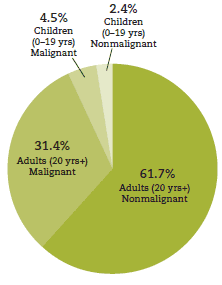Publication
Article
Oncology Live®
Oncology Links From Across the Web for Brain Cancer
Author(s):
Links to resource from across the web for brain cancer; includes news briefs, patient education, research and clinical trials
(Based on 213,525 people)
Distribution of Brain Tumors in the US 2004—2007

The National Cancer Institute delved into the diversity of brain tumors in its latest Annual Report to the Nation on the Status of Cancer. National Cancer Institute
//The Educated Patient™
Making Connections
The National Brain Tumor Society hosts My.BrainTumor. Community.org, a site that contains links to community events, blogs, forums, peer-to-peer matching, support groups, and even information on treatment centers. The site also posts news articles and weekly highlights on new topics in the brain tumor community.
//News Brief
“Get Your Head in the Game”
Preparations for the 4th annual “Get Your Head in the Game” awareness walk are underway. This walk and community day benefit the Kelly Heinz-Grundner Brain Tumor Foundation, a subsidiary of the National Brain Tumor Society. Last year, approximately 2800 people participated in the walk and raised around $160,000. The walk takes place April 30 in Wilmington, Delaware. Registration begins at 1:30 pm, with events starting at 2:30 pm and ending around 5 pm.
//Research Highlight
Metabolomics Study Provides Insight into Gliomas
Researchers from Duke University Medical Center and Johns Hopkins University School of Medicine studied metabolomic profi ling in >200 IDH1- and IDH2-expressing human oligodendroglioma (HOG) cells. Findings from their study revealed that altered metabolism in the cells provided clues to the pathogenesis of tumors with IDH1 and IDH2 mutations (Proc Natl Acad Sci. 2011;108[8]:3270-3275).
IDH1 and IDH2 mutations are associated with central nervous system tumors that typically respond poorly to therapy. The researchers believe that understanding metabolic alterations in tumor cells will be helpful in devising targeted therapies that do not cause harm to healthy tissue.
“Remarkably, N-acetyl-aspartyl-glutamate (NAAG), a common dipeptide in [the] brain, was 50-fold reduced in cells expressing IDH1 mutants and 8.3-fold reduced in cells expressing IDH2 mutants,” the researchers said in their abstract. “NAAG also was significantly lower in human glioma tissues containing IDH mutations than in gliomas without such mutations.”
Metabolon, Inc, a diagnostic services company whose laboratory was used in the study, said the fi ndings demonstrate the insight that can be obtained though metabolomics analyses. Metabolon is located in Research Triangle Park, North Carolina.
Metabolomics Study Provides Insight into Gliomas
//Clinical Trial
Gliogene: Brain Tumor Linkage Study
STUDY TYPE: Observational
AGE/SEX REQUIREMENTS: None
SPONSOR: MD Anderson Cancer Center
CLINICALTRIALS.GOV IDENTIFIER: NCT00418899
Purpose: This study investigates the role of genes that may point to a higher risk of developing a glioma. After screening data from about 17,080 patients, the researchers will identify 400 families for genetic analysis, then establish a cohort of the first- and second-degree relatives from those families. The study aims to collect information about how cancer masses in glioma families and identify regions linked to familial brain tumors. The researchers will then map the identified regions by genotyping selected single nucleotide polymorphisms. The study is slated for completion by February 2017.










